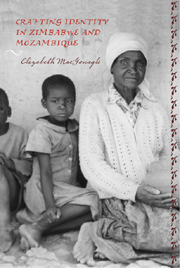Book contents
- Frontmatter
- Contents
- List of Illustrations
- Acknowledgments
- 1 A Mixed Pot: The Crafting of Identity
- 2 The Historical Landscape of Southeast Africa
- 3 Early Exchanges: Political and Economic Contexts
- 4 Ties That Bind: Social Structures and Cultural Practices
- 5 Keeping up Appearances: Identity and Adornment
- 6 Brewing Beer, Making Rain, and Holding Court
- 7 Memories and Identities in the Shadow of Ngungunyana
- 8 Past and Present in the Ndau Region
- Notes
- Glossary of Ndau and Portuguese Words
- Bibliography
- Index
- Rochester Studies in African History and the Diaspora
4 - Ties That Bind: Social Structures and Cultural Practices
Published online by Cambridge University Press: 12 September 2012
- Frontmatter
- Contents
- List of Illustrations
- Acknowledgments
- 1 A Mixed Pot: The Crafting of Identity
- 2 The Historical Landscape of Southeast Africa
- 3 Early Exchanges: Political and Economic Contexts
- 4 Ties That Bind: Social Structures and Cultural Practices
- 5 Keeping up Appearances: Identity and Adornment
- 6 Brewing Beer, Making Rain, and Holding Court
- 7 Memories and Identities in the Shadow of Ngungunyana
- 8 Past and Present in the Ndau Region
- Notes
- Glossary of Ndau and Portuguese Words
- Bibliography
- Index
- Rochester Studies in African History and the Diaspora
Summary
Bridewealth into the family!
—Midwife's announcement after the birth of a girlKuwanikwa igwara, vasikana vose vanofamba naro.
Marriage is like a path which all girls have to use.
—Shona proverbThis is the first of three chapters that look at how Ndauness was shaped within societies in this corner of southeast Africa. Several long-standing, interdependent social structures and cultural practices bound Ndau communities together over successive generations and across a vast region. Modes of social and political organization such as households, lineages, totems, clans, villages, and chieftaincies were crucial elements of a Ndau sociocultural milieu. The Ndau regulated life-cycle events such as birth, marriage, and death through practices that reinforced the social order. A hierarchical system ensured, in most cases, that power flowed from paramount chiefs to lesser chiefs and their village headmen. A council of male elders assisted leaders in making decisions at the village level, and patriarchy was reinforced in daily household life where male authority was evident. The Ndau responded to stresses in their social world by relying on the judgment of their leaders and established “safety nets” designed to deal with problems such as troubled marriages and food shortages. People turned to their own granaries or the more abundant food reserves of chiefs, for instance, in times of drought or locust plagues. The Ndau consciously initiated changes in their social structures and cultural practices in response to shifts in the political and economic landscape.
- Type
- Chapter
- Information
- Crafting Identity in Zimbabwe and Mozambique , pp. 53 - 69Publisher: Boydell & BrewerPrint publication year: 2007



